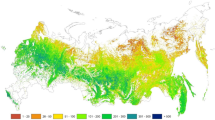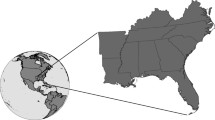Abstract
Carbon trends of U. S. timberlands reflect past and current harvesting patterns and forest growth. Using periodic forest inventory data coupled with the Carbon Budget Model, we estimate C inventory from 1952 to the present, and project future trends through 2070. Two sets of projections are presented, one based on economically derived harvest levels and the other assuming no harvests after 1990. Productive forests sequester an average of 250 Tg C yr−1 from 1952–1987, but projections under expected harvests assuming no changes in growing conditions indicate this rate will fall to 60 Tg C yr−1 from 1987 to at least 2050, and then become a C source by 2070. Carbon sequestered in products and landfills over the projection period average 75 Tg C yr−1. An estimated 328 Tg C yr−1 would be sequestered if harvesting ceased.
Similar content being viewed by others
References
Adams, D.M. and Haynes, R.W.: 1980,Forest Science 26, Monograph 22, 64 p.
Alig, R.J.: 1985,Forest Science 32, 119–134.
Anderson, J.M.: 1992,Advances in Ecological Research 22, 163–210.
Birdsey, R.A.: 1992a,Carbon storage and accumulation in United States forest ecosystems, Gen. Tech. Rep. WO-59, U.S. Department of Agriculture, Forest Service, Washington, DC, 51 p.
Birdsey, R.A.: 1992b, Changes in forest carbon storage from increasing forest area and timber growth, in: Sampson, R.N. and Hair, D. (eds),Forests and Global Change, Vol. 1: Opportunities for Increasing Forest Cover, American Forests, Washington, DC, pp. 23–39 and App. 2.
Birdsey, R.A., Plantinga, A.J., and Heath, L.S.: 1993,Forest Ecology and Management 58, 33–40.
Burke, I.C., Yonker, C.M., Parton, W.J., Cole, C.V., Flach, K., and Schimel, D. S: 1989,Soil Sci. Soc. Am. J. 53, 800–805.
Cost, N.D., Howard, J., Mead, B., McWilliams, W.H., Smith, W.B., Van Hooser, D.D., and Wharton, E.H.: 1990,The biomass resource of the United States. Gen. Tech. Rep. WO-57, U.S. Department of Agriculture, Forest Service, Washington, DC, 21 p.
Dewar, R.C. and Cannell, M.G.R.: 1992,Tree Physiology 11, 49–71.
Gansner, D.A., Birch, T.W., and Lacy, S.E.: 1991,American Forests 97, 48–49.
Haynes, R.W. (coord.): 1990,An Analysis of the Timber Situation in the United States: 1989–2040, General Technical Report RM-199, U.S. Department of Agriculture, Forest Service, Rocky Mtn. Forest and Range Expt. Stn., Fort Collins, CO.
Haynes, R.W. and Adams, D.M.: 1985,Simulations of the Effect of Alternative Assumptions of Demand-Supply Determinants on the Timber Situation in the United States, USDA Forest Service, Forest Economics Research, Washington, DC.
Johnson, D.W.: 1992,Water, Air, and Soil Pollution 64, 83–120.
Kauppi, P.E., Mielikäinen, K., and Kuusela, K.: 1992,Science 256, 70–74.
Koch, P.: 1989, Estimates by species group and region in the USA of: I. Belowground root weight as a percentage of ovendry complete-tree weight; and II. carbon content of tree portions, Consulting report, 23 p.
Kurz, W.A. and Apps, M.J.: 1993,Environmental Pollution,In press.
Kurz, W.A., Apps, M.J., Webb, T.M., and McNamee, P.J.: 1992,The Carbon Budget of the Canadian Forest Sector: Phase I., Forestry Canada, Northwest Region, Northern Forestry Centre, Edmonton, Alberta, Inf. Rep. NOR-X-326. 93 P.
Marland, G. and Marland, S.: 1992,Water, Air, and Soil Pollution 64, 181–195.
Mills, J.R. and Kincaid, J.C.: 1992,The Aggregate Timberland Assessment System-ATLAS: A comprehensive timber projection model. Gen. Tech. Rep. PNW-GTR-281, U.S. Department of Agriculture, Forest Service, Pacific Northwest Research Station, Portland, OR, 160 p.
Pastor, J. and Post, W.M.: 1986,Biogeochemistry 2, 3–27.
Plantinga, A. J. and Birdsey, R.A.: 1993,Climatic Change 23, 37–53.
Post, W.M., Emanuel, W.R., Zinke, P.J., and Stangenberger, A.G.: 1982,Nature 298, 156–159.
Reynolds, R.V., and Pierson, A.H.: 1941,The sawtimber resource of the United States, 1630–1930, Forest Survey Release, U.S. Department of Agriculture, Forest Service, Washington, DC, 21 p.
Row, C. and Phelps, R.B.: 1991, Carbon cycle impacts of future forest products utilization and recycling trends, in:Agriculture in a World of Change, Proceedings of Outlook '91, 67th Annual Outlook Conference, U.S. Department of Agriculture, Washington, DC.
Sedjo, R.A.: 1992,Ambio 21, 274–277.
U.S. Department of Agriculture: 1928,American forests and forest products, Statistical Bulletin No. 21, U.S. Government Printing Office, Washington, DC, 17 P.
U.S. Department of Agriculture, Forest Service: 1958,Timber resources for America's future, For. Resour. Rep. 14., U.S. Government Printing Office, Washington, DC, 713 p.
U.S. Department of Agriculture, Forest Service: 1965,Timber trends in the United States, For. Resour. Rep. 17, U.S. Government Printing Office, Washington, DC, 235 p.
U.S. Department of Agriculture, Forest Service: 1974,The outlook for timber in the United States, For. Resour. Rep. 20, U.S. Government Printing Office, Washington DC, 367 p.
U.S. Department of Agriculture, Forest Service: 1982,An analysis of the timber situation in the United States: 1952–2030, For. Resour. Rep. 23, U.S. Department of Agriculture, Forest Service, Washington, DC, 499 p.
U.S. Department of Agriculture, Forest Service: 1988,The South's fourth forest: alternatives for the future, For. Resour. Rep. 24, U.S. Department of Agriculture, Forest Service, Washington, DC, 512 p.
Vogt, K.A., Grier, C.C., and Vogt, D.J.: 1986,Advances in Ecological Research 15, 303–377.
Waddell, K.L., Oswald, D.D., and Powell, D.S.: 1989,Forest statistics of the United States, 1987, Resour. Bull. PNW-RB-168, U.S. Department of Agriculture, Forest Service, Pacific Northwest Research Station, Portland, OR, 106 p.
Watson, R.T., Meira Filho, L.G., Sanhueza, E., and Janetos, A.: 1992, Greenhouse gases: sources and sinks, in: Houghton, J.T., Callander, B.A., and Varney, S.K.,Climate Change 1992: The Supplementary Report to the IPCC Scientific Assessment, Intergovernmental Panel on Climate Change, World Meteorological Organization /U.N. Environment Program, Cambridge University Press, Cambridge, Great Britain.
Woodwell, G.M., Hobbie, J.E., Houghton, R.A., Melillo, J.M., Moore, B., Park, A.B., Peterson, B.J., and Shaver, G.R.: 1984, Measurement of changes in the vegetation of the earth by satellite imagery, in: G.M. Woodwell (ed),The Role of Terrestrial Vegetation in the Global Carbon Cycle: Measurement by Remote Sensing, SCOPE No. 23, John Wiley and Sons, Ltd, 272 p.
Author information
Authors and Affiliations
Rights and permissions
About this article
Cite this article
Heath, L.S., Birdsey, R.A. Carbon trends of productive temperate forests of the coterminous United States. Water Air Soil Pollut 70, 279–293 (1993). https://doi.org/10.1007/BF01105002
Issue Date:
DOI: https://doi.org/10.1007/BF01105002




